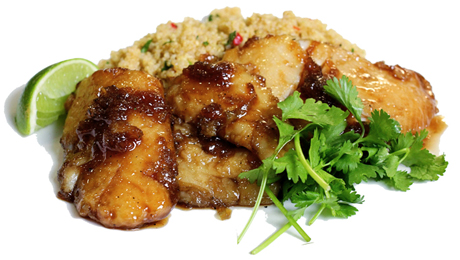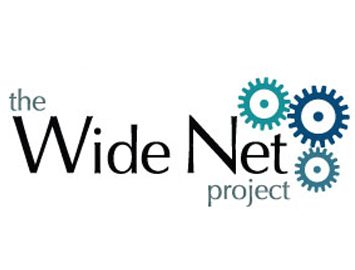The George Washington University Campus Dining has joined the fight to conserve the Chesapeake Bay by serving wild blue catfish, an overpopulated species whose large appetite has the potential to devastate the ecosystem of the Maryland watershed.
The menu addition, which debuted in April, is the result of a partnership between GW, Sodexo and the Wide Net Project, a local nonprofit that facilitates the harvesting of wild blue catfish for public consumption.
GW is the first Sodexo account to partner with the Wide Net Project.
“The Office of Sustainability brought the Wide Net Project to our attention, and we were able to work with Sodexo to bring this exciting pilot program to campus,” Campus Dining General Manager Bernadette Thomas said. “This partnership furthers our efforts to bring local, sustainable food to the campus community.”
The university purchased 60 pounds of fresh wild blue catfish for the first test of the program. A Thai chili catfish dish sold out in its first run.
The university intends to purchase more catfish for campus dining during the fall semester.
“President Knapp recently signed the Real Food Challenge,” Ms. Thomas said. “The Wide Net Program, as a local, sustainable initiative, is another way to move the needle on our efforts in a positive direction.”
Wide Net Project cofounders Wendy Stuart and Sharon Feuer Gruber said that the goal of the program is to not only ease the predatory effects of the species but to also provide healthy food to underserved communities.
“Together, Wide Net, Sodexo and GW have launched this pilot program with the hope that by successfully engaging the university community, we can grow in the region,” Ms. Stuart said. “GW has really been a champion of this partnership.”
“The exciting thing about working with Sodexo and GW is the potential for a large-scale impact,” Ms. Gruber added.
“Catch of the Day” Turned Predator
A slate-blue-bodied, silver-bellied native of the Ohio, Missouri and Mississippi basins, the wild blue catfish can live for more than 20 years and grow to more than 100 pounds.
Its diet is varied, consisting of insects, plants, Maryland blue crabs and fish native to the bay.
The species was introduced in the James, Rappahannock and York rivers in Virginia for recreational fishing in the 1970s. Currently, 20 states stock wild blue catfish for sport.
Though the wild blue catfish started out as the “catch of the day,” it grew into an invasive species in the 1980s, spreading to the Chesapeake Bay watershed and shifting the balance of the ecosystem.
In 2012, the Chesapeake Bay office of the National Oceanic and Atmospheric Association (NOAA) established a team of representatives and scientists from federal agencies and fisheries for the Sustainable Fisheries Goal Implementation Team to combat the rapid spread of wild blue catfish in the bay.
The Maryland Department of Natural Resources also encourages recreational fishermen, known as anglers, to catch wild blue catfish.
This is where the Wide Net Project Steps in.
“Wide Net Project’s mission is to address two problems simultaneously that are often not linked together,” Ms. Gruber said. “First, we want to address healthy food access for underserved communities and, second, conservation in the Chesapeake Bay related to the overpopulation of the wild blue catfish.”
“Consumption is the best solution for reducing the wild blue catfish populations and restoring balance in the bay,” she said.
"Wide Net Project’s mission is to address two problems simultaneously that are often not linked together. First, we want to address healthy food access for underserved communities and, second, conservation in the Chesapeake Bay related to the overpopulation of the wild blue catfish.”
Building a Sustainable Solution
Both Ms. Stuart and Ms. Gruber agree that the premise of the Wide Net Project—sourcing wild blue catfish from the Chesapeake Bay, funneling the catch through local processor and distributor J.J. McDonnell and providing fish to restaurants, universities and nonprofits for consumption— is a simple solution to a devastating problem.
“Using this economic model to serve the public good by helping organizations provide healthy food, including fish, has made our message much stronger,” Ms. Gruber said. “Linking the environmental message with hunger relief has allowed us to connect with sustainable efforts on multiple levels.”
Harvesting the fish provides income to fishers and reduces the population and predation of the wild blue catfish, thereby, restoring populations of Maryland blue crab and other species, she said.
The Wide Net Project also creates local partnerships with organizations, such as the Arcadia Center for Sustainable Food and Agriculture, to increase access to healthy food, specifically protein, in underserved communities by subsidizing the cost of the fish.
“As more organizations sign on and our volume increases, we can subsidize the fish and offer lower prices and higher volumes,” Ms. Stuart said.
Ms. Gruber added that the best way for students to get involved is to speak up about the program.
“One way that students can engage in hunger relief and biodiversity in the Chesapeake Bay is to tell their favorite restaurant about the Wide Net Project and request the wild blue catfish at their university,” Ms. Gruber said.
Continuing the Cause at GW
In addition to the partnership with the Wide Net Project and the Real Food Challenge, GW has enhanced sustainable engagement at the university through the GroW Garden, Meatless Mondays, the Urban Food Task Force and other initiatives.
Most recently, the university connected with Communications Director of the Animal Agriculture Alliance (AAA) Emily Meredith, B.A. ’09, who invited four students to participate as panelists at the AAA Stakeholders Summit .
GW students—GroW Garden Manager Jesse Schafer, Student Dining Board member Eric Estroff, Jennifer Weinberg, who grew up on a cattle farm, and Student Eco Rep Miles Milliken—discussed how they perceive, assess and interact with food with milk, meat and egg producers who were eager to continue discussions throughout the day.
“We thought what better way to understand what millenials are thinking about the food they eat than to bring them into a dialogue with stakeholders and Rob Morasco, the senior director of offer development at Sodexo,” Ms. Meredith said. “We wanted to know how, why and where they get information about the food they eat.
Ms. Meredith credits her background at GW for the spark that helped her pursue agriculture and said that she is excited that sustainable food programming is integral to the university’s goals.
“Looking at GW’s sustainability efforts, I think that going forward there will be a lot of opportunities to engage,” Ms. Meredith said. “We are looking forward to seeing what GW does next.”



